Gentle Yoga chair exercises to improve senior citizens’ mobility. Increase your wellbeing and flexibility, our instructional routines to live healthier lives.
Table of Contents
Yoga Chair Exercises Overview
The phrase “yoga is for everyone” is common these days. But is it the case? Can everyone practice it? Even those who must practice entirely from a chair owing to injury, inflexibility, or age?
Definitely!
Elders might benefit from chair yoga more than most students do. Older students can bring more vital general awareness to yoga, leveraging the mind-body connection better than younger students since the brain’s two hemispheres are used differently as we age.
Remember that many physically healthy seniors have no restrictions about doing chair yoga, with the possible exception of possibly utilizing the adaption tools that many younger people use, like blocks or straps. However, for certain people, yoga on chairs may be the best option:
Having balance problems
Attempting to begin gently
An individual would feel more assured beginning in this manner.
It can help improve the lubrication of joints, balance, and even specific age problems like menopause and arthritis, in addition to the advantages of regular chair yoga, such as easing tension, pain, and exhaustion.
Anyone who wants to practice chair yoga, including older people or people at work, will benefit from this routine. Remember that you’ll want a stable chair in which you feel secure and comfortable. That includes nothing that seems shaky, even office chairs with wheels.
And make sure your butt is securely planted in the seat before beginning each new stance. While remaining sufficiently seated to feel stable, you should sit closer to the forward edge of the chair.
Tadasana (English Name: Mountain Pose)

To satart with with asana for chair yoga, simply focusing on your breath, checking in through your posture, and engaging your core are all fantastic things to do in this pose. After striking each of the stances below, hit this one.
- Inhale profoundly and sit up straight, letting your spine lengthen.
- Put your sit bones—the lowest section of your tailbone or both of the points that support your weight when you sit—into the chair as you exhale.
- Knees should be directly over ankles, and legs must be at 90-degree angles. There should be some space between your knees. Usually, your fist should fit in the space between your thighs, though your bone structure might need more space.
- As you exhale, take a deep, profound breath and relax your shoulders down into your back, belly button toward the spine, and arms down at the sides. If the seat has armrests, move them slightly or somewhat broader out to the front so they are free of the armrests.
- Lift your toes and plant your feet firmly into each of the four corners to activate your legs.
Virabhadrasana (English Name: Warrior Pose)
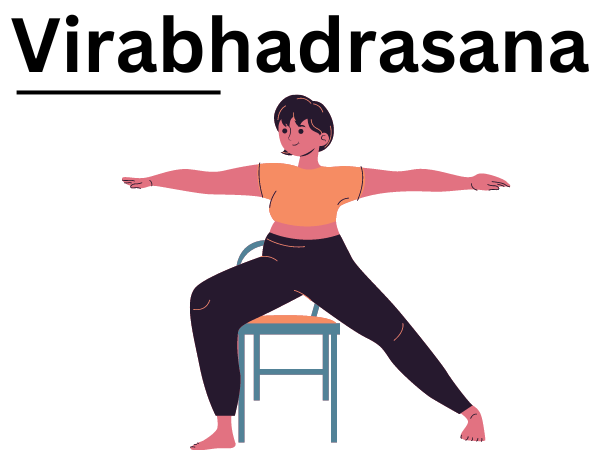
- Start in Seated Mountain and inhale deeply. Raise your arms wide to the edges as you inhale, then bring your hands together above your head.
- As you aim directly up at the ceiling, lace the tips of your fingers together while keeping your thumbs and pointer fingers out.
- Roll the shoulders far from your ears as you exhale, allowing your shoulder blades to descend your back. This will activate the shoulder capsule, which comprises the muscles that stabilize your shoulder joint.
- As you settle down, keep inhaling profoundly and evenly. Take at least five deep breaths before releasing your joined hands and letting your arms slowly fall back to your sides.
Paschimottanasana (English Name: Seated Forward Bend)
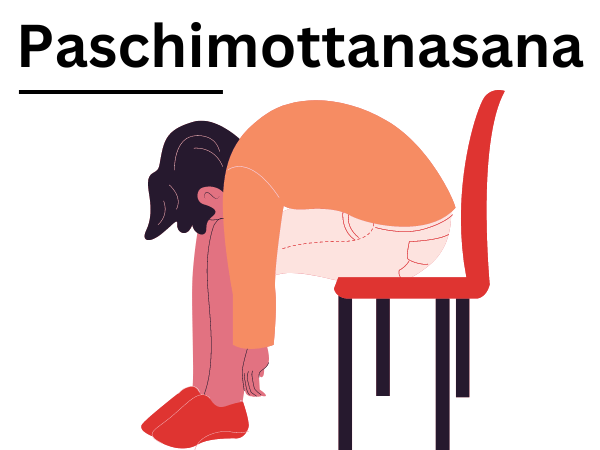
- Fold your legs over after taking a deep breath in Seated Mountain while concentrating on lengthening your spine. For a little additional assistance, you may begin with your hands on your legs and move them down your feet when you fold, or you may maintain your hands at the sides as you go toward placing your body on your thighs.
- In this position, take five or more slow, even breaths. It also passively lengthens your spine and stretches your back muscles while massaging your intestines to aid digestion.
- When ready, take a deep breath and raise your torso.
Garudasana (English Name: Eagle Pose)
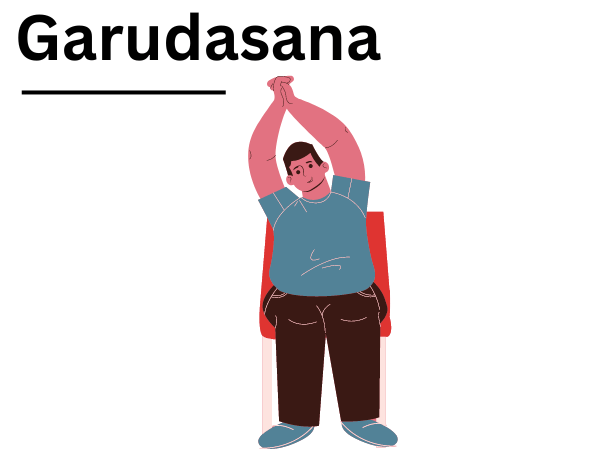
- As your shoulder joint is stabilized and flexed in this pose, your arms and upper back are relaxed.
- As you inhale, extend the arms out to the sides. Take a breath.
- Swing your right arm beneath your left and grip the shoulders using the opposite hands as you exhale to hug yourself.
- If your shoulders are more flexible, you can let go of your grasp and keep encircling your forearms until your right fingers rest in your left palm.
- Lift the elbows a couple of inches higher while inhaling.
- Rolling your shoulders out toward your ears while exhaling will relax them.
- Take a few deep breaths and, if you would like, repeat the shoulder roll and elbow raise.
Paschim Namaskarasana (English Name: Reverse Prayer pose)
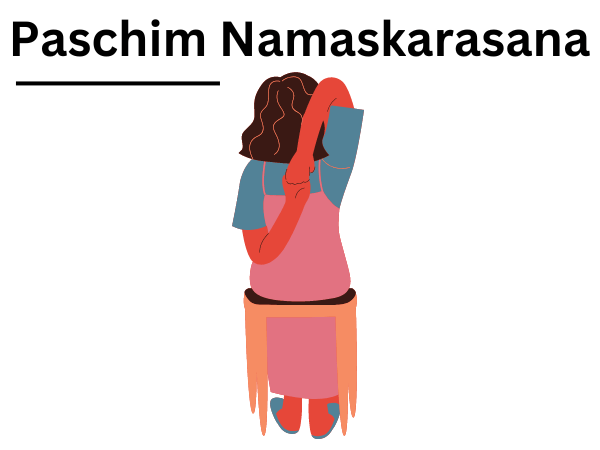
This can help improve your posture, anxiety, and breathing issues by stretching your shoulders and opening up your chest.
- Palms facing down. Extend each arm out to the sides as you breathe.
- When you exhale, rotate your shoulders slightly forward so your palms face backward. Next, bend both elbows and allow your hands to swing across your back.
- You can keep hands together using the tips of your fingers, hands, wrists, and or elbows. Gently move your hands apart while maintaining your grip.
- Take note of which side it is if you hold onto your wrist or elbow.
- This time, grasp one wrist or elbow again and hold for five slow, even breaths. Then, release the clasp and repeat the exercise with the other arm.
Parivrtta Sukhasana (English Name: simple twist pose)
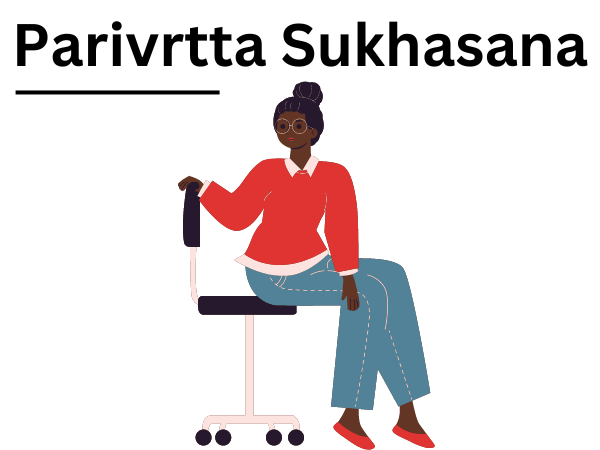
Twisting positions promote healthy circulation and digestion while easing lower back pain. They are frequently known as “detox” positions.
Even though you can lean back in your chair to aid in your twist, bear in mind that you do not want to utilize it to pull yourself into a more profound twist. Your entire body will be equipped with a built-in halting mechanism. Don’t pull with your hands to make it happen. A twist that is forced can result in severe harm.
- Extend your spine once more as inhale, and lift your arms to the sides.
- With your arms at your sides and your right hand resting on the highest point of the chair’s back, slowly twist your upper torso to the right as you exhale. The hand on your left will remain at your side.
- Take a right-shoulder glance. Hold onto the chair with your hands to maintain your twist but avoid making it deeper.
- Loosen this twist and face the front after five breaths. Continue onto your left side.
Janu Sirsasana (English Name: Head-to-Knee Pose Yoga)
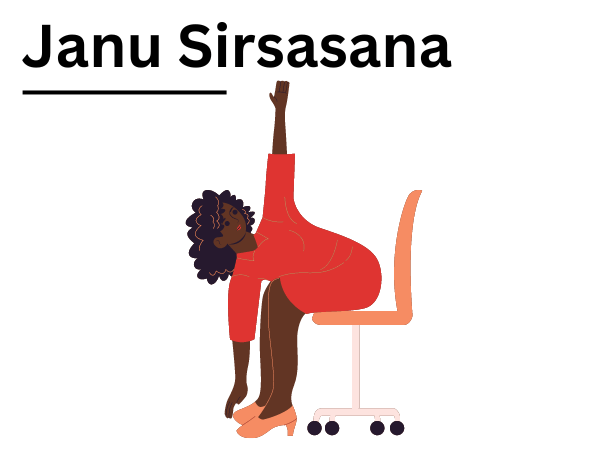
For this one, you can get nearer to the border of your seat. Just make sure you are seated firmly enough to prevent falling off.
- With your right leg extended and your heel resting on the floor with your toes facing up, sit up straight. The closer you are to the border of the seat, the straightened your leg can be. But once more, consider your support before bending forward.
- Place your hands on your extended leg. While exhaling, bend down your right leg while sliding both hands down the leg. As you inhale, lift through your spine.
- You can extend this section as much as you would like as long as you are not pushing or straining and still feel supported by the seat and your hands. Consider grabbing the inner side portion of your calves or ankle to see if you can extend your reach further on your leg.
- Release the position by employing an inhalation to help you rise after inhaling slowly and evenly five times, gradually descending each time. Repeat this position with your left foot extended, ensuring your torso is securely seated on the seat’s border and realigning your right leg’s knee down your ankle before bending over.
Final Takeaway
Seniors who practice chair yoga are encouraged to exercise and enjoy tremendous vigor and peace. A bridge between the body and the soul opens up via gentle movements and attentive breathing, luring a richer perception of wellbeing. Daily dedicated moments encourage adaptability, equilibrium, and a peaceful heart.
Challenges arise along the path of aging, yet grace and resilience persevere despite them. They accompany seniors with renewed energy and hope, much like dependable friends. A wholehearted embrace is sparked by the transforming power of chair yoga, which whispers tales of rediscovered vigor and strength. Let us work together to encourage this practice as we stand as silent witnesses for these journeys. Together, we foster better aging, ensuring that the golden years sparkle with vitality, happiness, and a web of wellness.
FAQ
-
Can seniors with limited mobility benefit from chair yoga?
Absolutely! For people of different mobility levels, there is chair yoga. It is ideal for seniors looking for a mindful, approachable fitness regimen because the gentle motions enhance flexibility and wellbeing.
-
How does chair yoga enhance emotional well-being?
The movement and breathing in chair yoga promote a calm mind-body connection. This routine fosters emotional balance by invoking feelings of tranquility and self-awareness.
-
Can chair yoga help seniors stay socially connected?
Certainly! A supportive community is created through group chair yoga sessions. Sharing smiles and motions strengthens relationships, fending against alienation and boosting moods.
